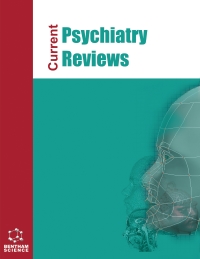- Home
- A-Z Publications
- Current Psychiatry Reviews
- Previous Issues
- Volume 3, Issue 4, 2007
Current Psychiatry Reviews - Volume 3, Issue 4, 2007
Volume 3, Issue 4, 2007
-
-
Pathways Leading to Suicide in Schizophrenia
More LessThe aim of this systematic review is to report the pre- and postmorbid trajectories leading to suicide in schizophrenia, with special focus on novel research published in 2003-2006. Individuals with schizophrenia who commit suicide seem to follow a developmental trajectory that differs partly from that of other schizophrenia patients. According to the studies analysed, there seem to be five main pathways for schizophrenia pat Read More
-
-
-
Self-Monitoring in Schizophrenia
More LessAuthors: Chloe Farrer and Nicolas FranckMany patients suffering from schizophrenia feel dispossessed from some of their actions or thoughts. This dispossession could result from impaired self-monitoring (SM), defined as the ability to monitor self-willed intentions and actions. SM has been widely studied during the past decades with very different paradigms; central error correction, feedback distortion, sense of effort, and motor imagery. The present article first revie Read More
-
-
-
Psychological Stress and the Development of Heart Disease
More LessUntil recently it was thought that no more than 50% of clinical coronary heart disease was explicable in terms of classical cardiac risk factors such as dyslipidemia, cigarette smoking, high blood pressure and diabetes. Recent large scale epidemiological studies have increased our understanding of the mechanisms generating cardiac risk and have provided evidence indicating that psychosocial factors, including stress at work and Read More
-
-
-
Atypical Major Depression - Past, Present, and Future
More LessThe term “Atypical Depression” refers to a subtype of mood disorder that has been most clearly associated with reversed neurovegetative features and interpersonal deficits such as rejection sensitivity and social avoidance. The most robust clinical correlates of atypical depression include a high preponderance of female cases, an early age of onset, and high rates of chronicity and co-morbidity. Particularly strong links to early ad Read More
-
-
-
Obsessive-Compulsive Disorder in the Perinatal Period: A Review of the Literature
More LessAuthors: Shaila Misri and Kristin KendrickFew studies have examined Obsessive-Compulsive Disorder (OCD) during the perinatal period. Existing data suggest there to be increased rates of OCD during this vulnerable period, with both new onsets and exacerbation of preexisting symptoms. The course of perinatal OCD appears to be varied, although trends suggest that symptoms in women with pre-existing OCD are likely to remain consistent throughout pregnancy an Read More
-
-
-
The Pathophysiological Role of the Serotonergic System in Tourette Syndrome
More LessTourette syndrome (TS) is defined as a chronic motor and vocal tic disorder. Because dopamine blocking drugs reduce tics it has been suggested that the dopaminergic system is pathophysiologically involved. However, comorbidities such as obsessive-compulsive behavior (OCB), depression, and anxiety are often associated suggesting that imbalances among other neurotransmitter systems may also exist. An increasing body Read More
-
-
-
Persistent Psychosis from Toluene Exposure; More Likely Coincidence than Cause: A Review of our Experience and the Literature
More LessAuthors: Herbert H. Schaumburg, Larry Wade and David MasurInhalant abuse of toluene is frequently accompanied by visual and auditory hallucinations that cease at varying intervals following withdrawal. One study of institutionalized abusers describes persistent hallucinations despite abstinence, with evolution into a “schizophreniform” psychosis. It is suggested that occupational exposure to toluene can have a similar outcome. Taken in concert with the credible neurological literature, Read More
-
-
-
Effects of Sleep Medications on Cognition, Psychomotor Skills, Memory and Driving Performance in the Elderly
More LessSleep disturbances occur more often in the elderly than in patients in any other age category. Traditional treatment regimens for insomnia in older patients have emphasized benzodiazepines. The useful anxiolytic and hypnotic properties of these agents have made them the most widely prescribed class of drugs in the world. Concern has been expressed however about the significant side effect profile associated with the Read More
-
Most Read This Month
Article
content/journals/cpsr
Journal
10
5
false
en


